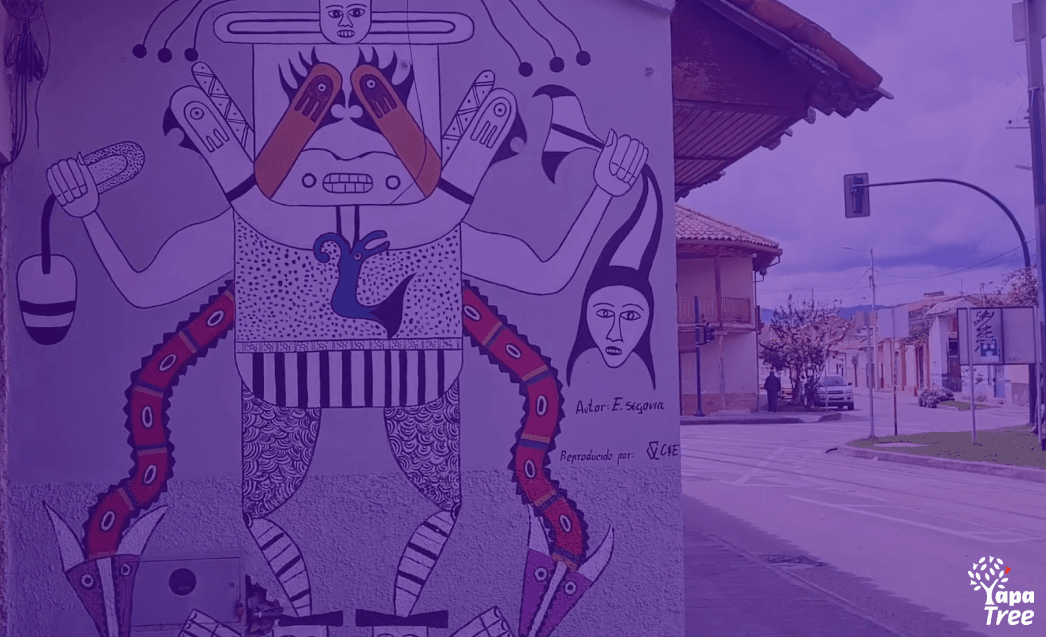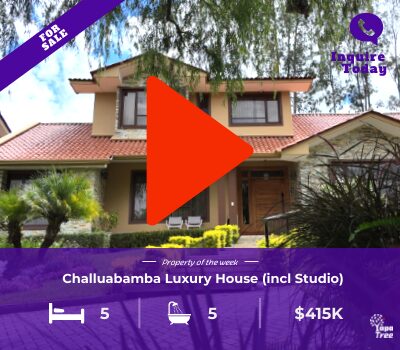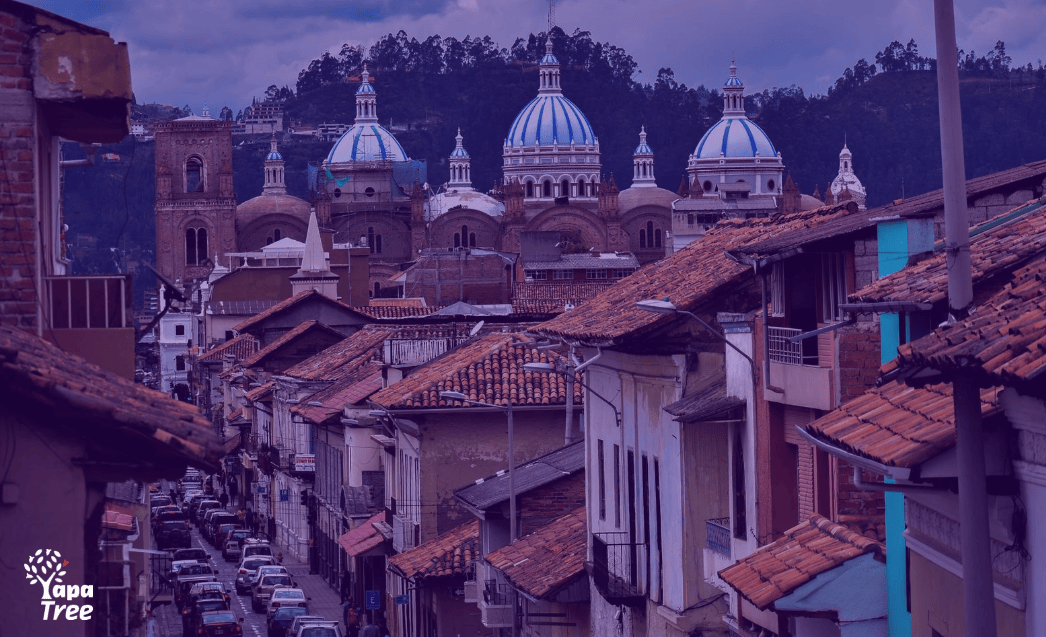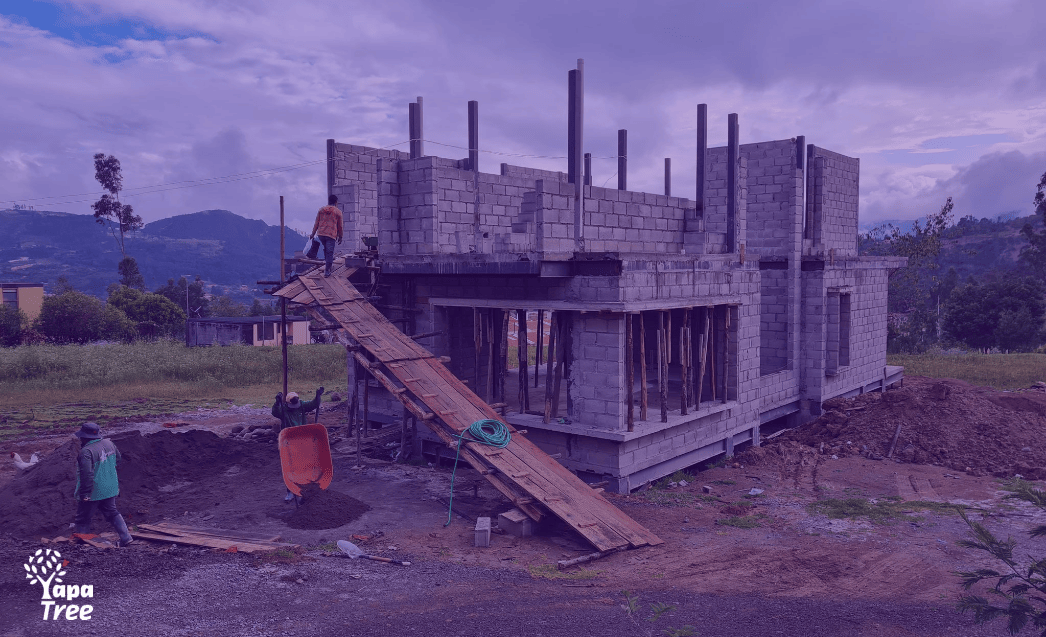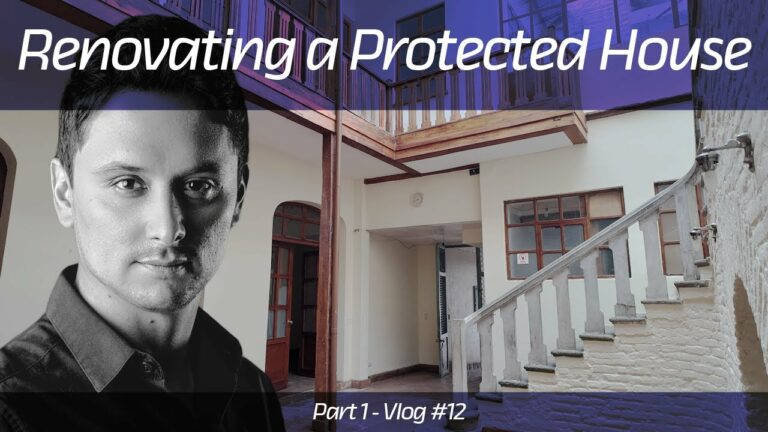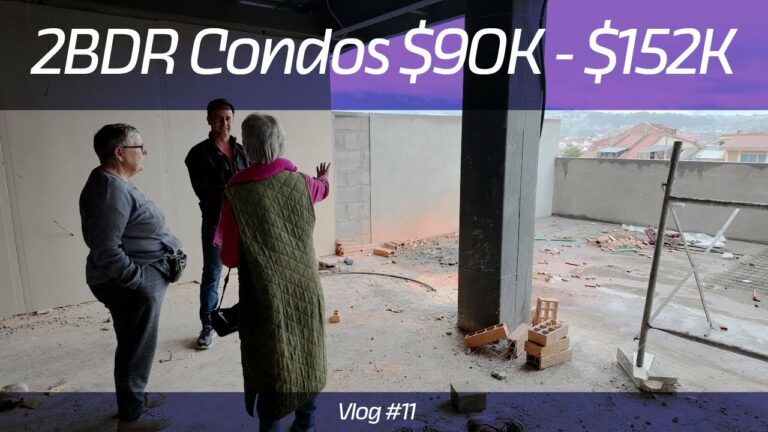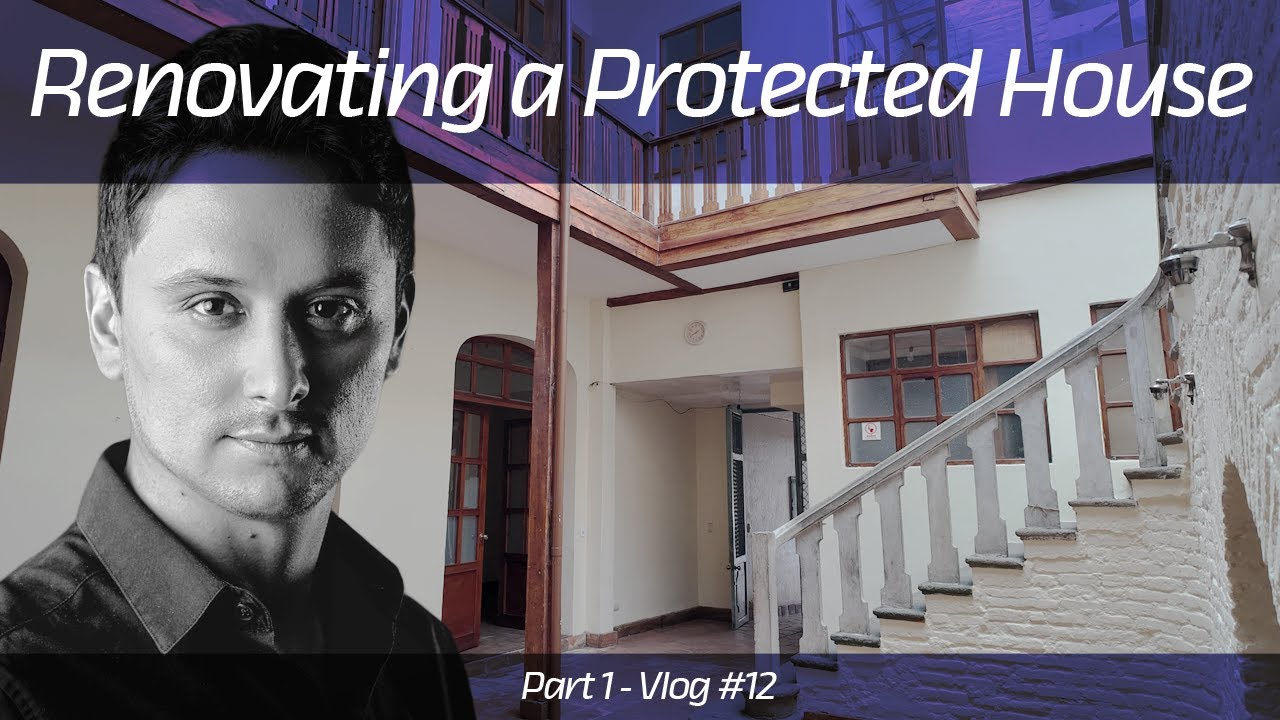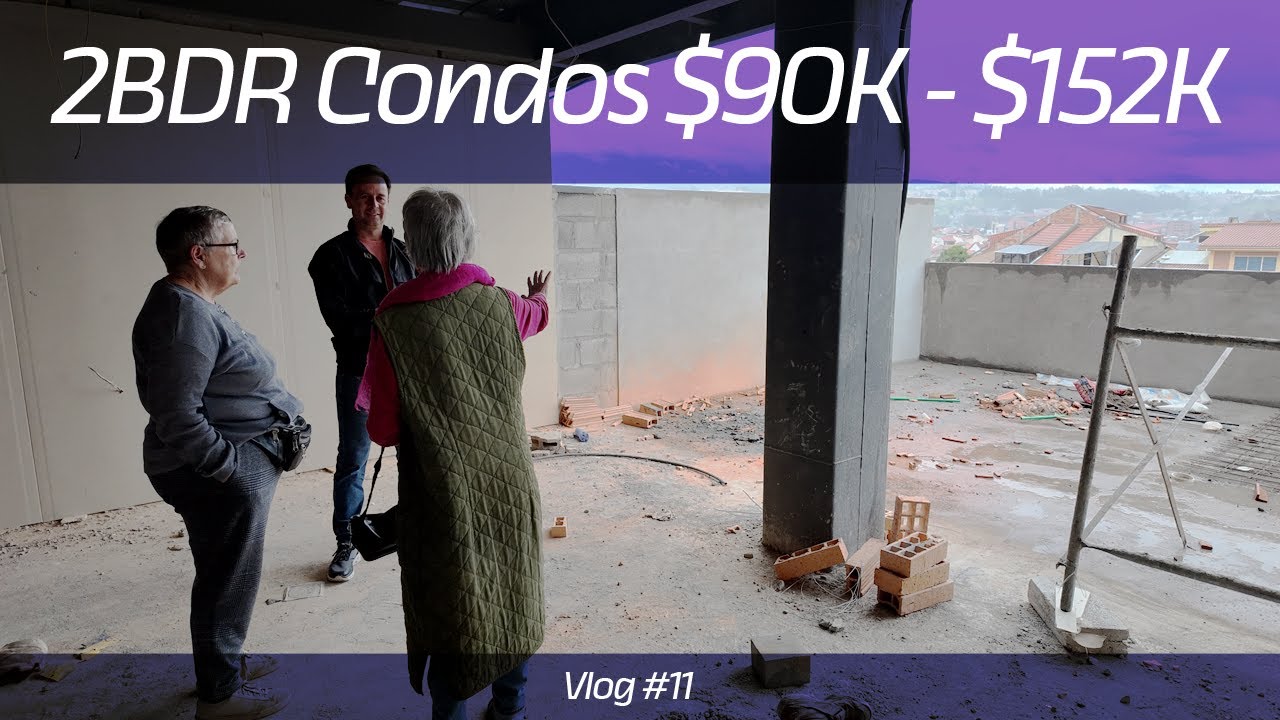Cuenca is frequently called “The Arts Capital of Ecuador,” and it takes only a walk around the city to see the ubiquity of art in the community. While the city is home to many visual artists, galleries, and art museums, the Cuencano passion for visual art has spilled out onto its streets, with murals adorning previously blank spaces large and small on the sides of buildings all across the city.
As mentioned in a previous YapaTree article, some of the notable sites for wall art are found on the charming Paseo de Noviembre 3 that parallels the Tomebamba River just below the Centro Historico. Murals of all are seen throughout Cuenca – with perhaps the largest and most dramatic one found on the side of a five-story building at the intersection of Av. 12 de Abril and Av. Fray Vincente Solano. One private citizen, Stan Young, even took to commission the creation of a mural to fill a large blank wall on one side of his home.
This article takes a deep dive into one particular project in the Convención del 45 neighborhood of Cuenca. This project centers around the art created by local legend, Eduardo Segovia, and now features 20 different mural sites that can be used as a map to find your way to his workshop.
We’ve also included a detailed (40 minute) video which features Andrés Zambrano visiting most of these mural sites and providing a lot of context and information about the project.
Let’s get to it!
Watch a video of our Mural Tour of Convención del 45 with Andrés Zambrano
A neighborhood beautification program becomes that and much more
The opportunity to fill a blank space with a work of art would be reason enough to promote the creation of murals, but a secondary benefit has been to discourage the painting of unsightly graffiti (or “tagging”) on bare building walls. A desire to improve the appearance of the Barrio Convención del 45, part of the western leg of Cento Historico that runs along Mariscal Lamar and Gaspar Sangurima, sparked the idea to use murals to spruce up the neighborhood and discourage graffiti. Business owners in the area had admired the murals that were painted in the nearby Tandacatu neighborhood and wanted to try a similar strategy in Convención del 45. The neighborhood association, led by its President Andrés Zambrano, owner of the La Guarida restaurant and performance venue on Mariscal Lamar, solicited donations and staged a concert to raise money to begin the project

The project grew quickly from a single mural in the neighborhood community center to 20 murals throughout the barrio. And while it has given the neighborhood a distinctive and artistic look along with discouraging graffiti, the project has become much more than a beautification project. It’s a significant walking art installation worthy of attention on its artistic merits, much as one might view an exhibit in a museum or gallery. Each of the murals is either a reproduction of or an homage to, the internationally known painter and ceramicist Eduardo Segovia, a lifelong resident of this traditional potters’ neighborhood who continues to live and work there. In fact, Segovía’s nickname is “El tiestero del Convención del 45” (the potter of Convención del 45.”
Overcoming the obstacles to installing murals throughout the neighborhood
Initially, neighborhood building owners were reluctant to allow murals to be painted on their walls, so Zambrano and the neighborhood association put the first one on a property they controlled – the neighborhood community house on Mariscal Lamar, near La Guarida. There was another barrier to overcome, though. As the center is a patrimonial building (one with landmark status), they were not allowed to paint on the walls. To work around this, they decided they would paint on the building’s door, which was not subject to the restrictions on patrimonial buildings. It was at this point that Zambrano approached Segovia to ask his permission to use his work in the mural project. Segovía granted the group rights, for no charge, to pull from his complete catalog of paintings and murals; and the artists Cristina and Edgar recreated Segovia’s “El dragon y la serpiénte” on the community house door.

For the second mural, Zambrano turned to his family and got permission to paint on a building owned by his grandfather, just a few doors west of the community house, again painting on the door to avoid patrimonial building restrictions. Cristina and Edgar reproduced Segovia’s “Pescador precolombino,” but with Segovia’s permission, added a small amount of color that is not in the original painting. They continued this practice in many of the murals that followed.
The idea takes flight and an art installation honoring Cuencano artist Eduardo Segovía becomes a reality
After a third mural, painted on another building owned by the Zambrano family, the idea took flight as neighbors began to approach Andrés and ask for murals to be painted on their buildings. When seven murals were completed, the neighborhood association approached the city’s Office of Cultural Affairs and received a grant of $5,000.00 to fund an additional 13 murals. While the initial murals were all on Mariscal Lamar, where they are visible from the westbound Tranvía, later murals were placed north of there, mostly along Calle Gaspar Sangurima, with many of them along the walls of the Colegio Victor Gerardo Aguilar, a high school of some 1,100 students. Once filled with graffiti, the walls of the school now host a series of murals featuring Segovia’s images of warriors from Latin American mythology. The corner of Gaspar Sangurima and Luis Pauta is now called the “Warriors Corner.” One of these murals – “Cazador de serpientes” at the corner of Gaspar Sangurima and Miguel Morocho, is an exact reproduction of Segovía’s painting, unlike others in this installation which have added color.

Among later murals are two original works by the artist Jonathan Mosquera, whose signature name is “Rayz,” that are homages to Segovia’s pottery. Rayz creates composites of images of Segovia’s pottery in the murals “Sin nombre” and “Corpus,” along the east wall of the school, on Calle Luis Pauta. And on the school’s north wall, directly across from Segovia’s home and workshop on Calle Paulino Ordoñez, is a mural called “Segoviana, “ created by a collective of artists known as PIB. Zambrano says this mural is particularly pleasing to Segovia, as he enjoys looking out at it from his home rather than at the graffiti that previously was there.

The fixture and features of the buildings become part of the art
Another notable feature of the Segovia murals is the way in which the artists have beautified mundane features on the buildings. On LaGuardia, Zambrano had Images of Segovia’s birds printed on adhesive paper and affixed on the building’s electric meter boxes. An auto repair shop on Luis Pauta now has its wall and door painted with a reproduction of Segovia’s “Hombre colombino paráca.” And up the street from that mural, in the mural “Shaman,” one of Segovia’s birds is painted behind one of the metal racks common in Cuenca for placing garbage bags for pickup, giving the impression (when the rack is not actually holding garbage bags) that the painted bird is caged. Zambrano says, “We love to play with what the city has.”

More a tribute to Eduardo Segovia than a retrospective
What makes this installation distinct from a traditional retrospective is the way in which Segovia has allowed his work to be adapted and quoted from rather than literally reproduced. In that way, it resembles the “variations on a theme,” found in music – or a stage director’s reinterpretation of a classic play. Many artists might not be so willing to let others adapt their work, but the 83-year-old Segovía is exceedingly humble. During our visit, he told us, “ Despite my 80 years of living and being with art, I have learned very little. Very, very little. I think I need another 80.”

How to see the complete installation of Segovia-inspired murals
While several of the murals are visible from the Tranvía as it winds westward along Mariscal Lamar, one should really make the effort to take the complete walking tour of all 20 murals. Maps of the murals are available at La Guarida, which 70 years ago was the boyhood home of Segovia and has many of his paintings on display inside the restaurant as well as a reproduction of one his birds on the building’s façade.
The walking tour route goes from La Guarida to the Segovia workshop, where one can see (and buy) pieces by the “Tiestero del Convención 45.” To arrange a visit to Segovía’s workshop, you can call him directly at 282 47 07, or arrange a visit through Andres Zambrano at La Guarida/ Galería El Tiestero at 099 806 8071.
Stan Young’s Personal Mural Project
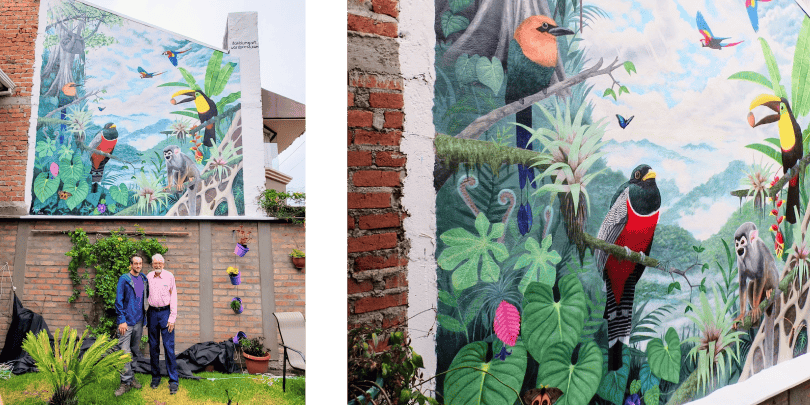
Stan Young is a Cuenca expat with many talents and interests. Being an adventurous and curious guy, Stan has enjoyed a long life, many interesting careers, and a worldview that is broader than most. Ultimately, it led to the creation of his own personal mural project. After tiring of the ugly, blank wall on one side of his home, he began to ponder a way to enhance his view of the garden. As a member of Couchsurfers, he has been hosted by other members around the world and also acted as host.
One of Stan’s recent guests turned out to be scientist and artist, Dan Blumgardt, visiting Ecuador from his home in Cornwall, England. Of course, their conversation ultimately drifted to the subject of The Ugly Wall Problem and the two hatched a plan to paint a mural there that Stan and his neighbors would enjoy. He invited friends to the unveiling ceremony and introduced them to Dan. Photos below from the unveiling ceremony in late March. Congratulations to Stan and Dan for their contribution to Cuenca’s beautification. Their project was the inspiration to develop this article on the many other murals around Cuenca.


